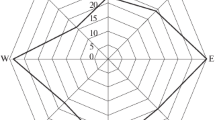Abstract
Studies were carried out in Yakutia (Nizhnekolymsk district) from May 15–20 to August 5–20 in 1984, 1985, 1987, 1988, and 1990. A total of 308 nests of ten wader species were found and described. The sizes of the waders’ nests correspond to those of the birds. The smaller wader species have heavier nests. The nests located in wet habitats are masked to a greater extent; they are deeper and have a thicker litter. The larger species, in which both parents incubate eggs, have the most open nests; these species breed in relatively dry habitats. The nests of small species, in which only one parent incubates eggs, are better equipped and masked; these birds breed in wetter sites. The location, shelters, and layouts of nests are related to the social organization of the species, namely, to the number of the birds incubating eggs.
Similar content being viewed by others
References
Byrkjedal, I., Nest predation in relation to snow-cover: a possible factor influencing the start of breeding in shorebirds, Ornis Scand., 1980, vol. 11, no. 3, pp. 249–252.
Calder, W.A., Consequences of body size for avian energetics, in Avian Energetics, Cambridge, MA: Nuttall Ornithological Club Publ., 1974, vol. 15, no. 15, pp. 86–152.
Calder, W.A., Size, Function, and Life History, Cambridge, MA: Harvard Univ. Press, 1984.
Cramp, S. and Simmons, K.E.L., Eds., The Birds of the Western Palearctic, vol. 3: Waders to Gulls, Oxford: Oxford Univ. Press, 1983.
Dolnik, V.R., Allometry of morphology, functions, and energetics of homeotherm animals, and its physical control, Zh. Obshch. Biol., 1982, vol. 43, no. 4, pp. 435–454.
Gavrilov, V.V., Reproduction biology and energetics of shorebirds in northeastern Yakutia, Cand. Sci. (Biol.) Dissertation, Moscow: Mosk. Gos. Univ., 1993.
Gavrilov, V.V., The location and concealment of goose nests in the tundra, in Kazarka: Byull. Rabochei gruppy po gusyam i lebedyam Vostochnoi Evropy i Severnoi Azii (Kazarka: Bulletin of the Working Group on Geese and Swans of Eastern Europe and Northern Asia), Moscow, 1998, no. 4, pp. 63–68.
Gavrilov, V.V., Size and design of shorebird nests in the Novaya Zemlya tundra, Tr. Menzbir. Ornitol. O-va, Makhachkala: ALEF, 2013, vol. 2, pp. 231–240.
Gladkov, N.A., Shorebirds (Charadriiformes), in Ptitsy Sovetskogo Soyuza (Birds of the Soviet Union), Moscow: Sovetskaya Nauka, 1951, vol. 3, pp. 3–371.
Hansell, M.H., Bird Nests and Construction Behavior, Cambridge, UK: Cambridge Univ. Press, 2000.
Hansell, M.H. and Deeming, D.C., Location, structure and function of incubation sites, in Avian Incubation: Behaviour, Environment and Evolution, Oxford: Oxford Univ. Press, 2002, pp. 8–27.
Heenan, C.B. and Seymour, R.S., Structural support, not insulation, is the primary driver for avian cup-shaped nest design, Proc. Roy. Soc. London B: Biol. Sci., 2011, vol. 278, pp. 2924–2929.
Irving, L., Arctic Life of Birds and Mammals (Including Man), Berlin: Springer, 1972.
Kondrat’ev, A.Ya., Biologiya kulikov v tundrakh severovostoka Azii (The Biology of Shorebirds in the Tundras of Northeastern Asia), Moscow: Nauka, 1982.
Kozlova, E.V., Charadriiformes: Suborder Charadrii, Fauna SSSR. Ptitsy, (The Fauna of the Soviet Union Birds), Moscow: 1961, vol. 2, no. 1, part 2.
Kozlova, E.V., Charadriiformes: Suborder Charadrii, Fauna SSSR. Ptitsy, (The Fauna of the Soviet Union Birds), Moscow: 1962, vol. 2, no. 1, part 3.
McCracken, K.G., Afton, A.D., and Alisauskas, R.T., Nest morphology and body size of Ross’ geese and lesser snow geese, Auk, 1997, vol. 114, pp. 610–618.
Mikhailov, K.E., Ecological and ethological features of the nesting of passerine birds in the tundra, in Ornitologiya (Ornithology), Moscow: Mosk. Gos. Univ., 1986, vol. 21, pp. 3–12.
Mikheev, A.V., Opredelitel’ ptich’ikh gnezd (An Identification Key to Bird Nests), 3rd ed., Moscow: Prosveshchenie, 1975.
Reid, J.M., Cresswell, W., Holt, S., Mellanby, R.J., and Whitfield, D.P., Nest scrape design and clutch heat loss in pectoral sandpipers (Calidris melanotos), Funct. Ecol., 2002, vol. 16, pp. 305–312.
Schmidt-Nielsen, K., Why Is Animal Size So Important?, Cambridge: Cambridge Univ. Press, 1984. Translated under the title Razmery zhivotnykh: pochemu oni tak vazhny?, Moscow: Mir, 1987.
Tulp, I., Schekkerman, H., and de Leeuw, J., Eggs in the freezer: energetic consequences of nest site and nest design in arctic breeding shorebirds, PLoS One, 2012, vol. 7, no. 6, e38041.
Author information
Authors and Affiliations
Corresponding author
Additional information
Original Russian Text © V.V. Gavrilov, 2015, published in Zoologicheskii Zhurnal, 2015, Vol. 94, No. 9, pp. 1077–1083.
Rights and permissions
About this article
Cite this article
Gavrilov, V.V. The Size and Layout of Waders’ Nests in the Yakutia Tundra (Nizhnekolymsk District). Biol Bull Russ Acad Sci 44, 728–734 (2017). https://doi.org/10.1134/S106235901707007X
Received:
Published:
Issue Date:
DOI: https://doi.org/10.1134/S106235901707007X




